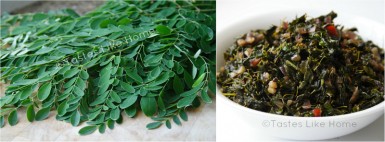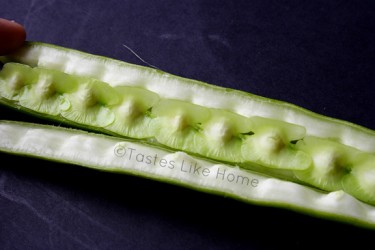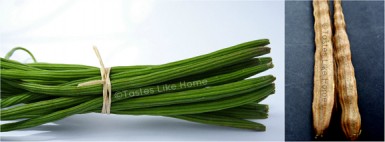Hi Everyone, I’m a huge fan of the Harry Potter series and Tolkien’s Lord Of the Rings trilogy, so last year when I read an article about Cuba mass planting the “Magic Tree”, I quickly wondered if it was the ‘tree of life’ Gandalf referred to in the Lord Of The Rings… just kidding! But then again, if one is to carefully study all the health benefits of the Moringa tree, not to mention its use in certain parts of the world to help poor nations fight food insecurity and malnutrition, it is easy to see why this tree is well known as the “Magic Tree”.
You are very familiar with this tree, it’s just that you might know it by another name: the Saijan Tree. Yup, that tree that’s probably in your backyard. The tree that bears the vegetable we love so much when we think of any type of fish curry. It is also known as the miracle tree, the multipurpose tree, the drumstick tree, the clarifier tree, and, wait for it… the tree of life!

The vendor proceeded to explain to me that this (the saijan) was no ordinary vegetable and she rattled off a list of all the things that saijan was good for. I ended up taking only 6 of the saijan (less than a pound). The rationale for the high cost was simply because of the nutrient-rich content of saijan.

Much of the Western world is now waking up to the multiple health benefits of Moringa and it is clear that people are cashing in on it. Native to Northern India, this tree – the roots, bark, leaves, flowers, fruit, seeds and oil – has been used in Ayurveda medicine for centuries. Ayurveda medicine is a system of traditional medicine native to India. What has caught the attention of scientists all over the world is not just the number of nutrients found in Moringa but the high amounts of the various nutrients it contains.
A lot of the nutrients are found in the leaves – in the fresh and dried form. It is more concentrated in the dried form – the fresh leaves are dried in the shade and then pounded to a powder.
In the powder form, gram for gram, Moringa is said to have:
● 10 times more Vitamin A than carrots
● 50 percent more Vitamin C than oranges
● 15 times more potassium than bananas
● 17 times more calcium than milk
● 25 times more iron than spinach
● 9 times more protein than yogurt
In the fresh form, gram for gram, Moringa is said to have:
● 3 times more iron than spinach
● 2 times more protein than yogurt
● 7 times more Vitamin C than oranges
● 4 times more Vitamin A than carrots
● 4 times more calcium than milk
● 3 times more potassium than bananas
The leaves can be eaten as greens (think spinach, callaloo), in salads, curries, pickles etc. According to the United States Department of Agriculture, Moringa contains 18 of the 20 amino acids – building blocks of proteins that are found in the human body. And according to Clinical Pharmacologist and author of the book, Miracle Tree, Dr Monica Marcu, Morniga is one of the few plants that contains all of the 9 essential amino acids the body cannot produce. The pod or the saijan vegetable itself is chock full of amino acids.
For decades, the World Health Organisation has been successfully using Moringa to treat malnourished infants and lactating mothers in different parts of the world (the leaves are dried, ground into a powder and sprinkled over food at all 3 meals; it is also sold in its fresh from – leaves and vegetable). Apart from India and Africa, the use of Moringa is wide spread in South East Asia and Hawaii among other places. We already have it here in the Caribbean and in other parts of South America but I am not sure if we use it for its full potential as a source of nutrients and medicinal properties. Cuba has successfully grown Moringa and continues to expand its production to take full advantage of all the Moringa tree has to offer.

Moringa powder is not only sold in its loose powder form but also as capsules. Fortunately we don’t have to bother about pricey capsules due to the ready access to every part of the Moringa tree. I would suggest incorporating the fresh leaves and pods into our meals or drying the leaves ourselves and making our own powder. The leaves should be dried in the shade and not the sun so as not to lose any of their potency.
Plant Biologist, Dr Mark Olson, says the oils from the seeds (of the dried saijan – the vegetable) can be used for cooking, cosmetics and lubrication. The stuff left over from the pressing of the seeds (for oil), is then used for water purification. The seed is a natural coagulant and when added to water it helps to treat cloudy water by pulling together floating particles including dirt, and some germs, and when the water settles, the particles sink to the bottom of the water container making the water clear! This is another of the many reasons that the Moringa tree is such a huge success story in many remote villages in the developing world where clean water is hard to come by. Let me hasten to add that after this first stage of purification, the water would still need to be filtered for other microorganisms before it can be drunk.
I’ve been using the fresh leaves just as I would spinach/callaloo. I get leaves from my neighbour but I don’t like to bother her often. I have to look for another source to get my saijan leaves. In terms of taste, it acts and tastes just like callaloo. The leaves once cooked are a little firmer so I’ve taken to adding some water to it when I am cooking, or if I have, some coconut milk.
Sometimes I cook it on its own and then there are other times that I would cook it with eddo or thick-leaf callaloo. I think a few leaves thrown into a smoothie is a good idea too. To be honest, because the leaves are so full of nutrients, adding a handful of leaves to most of the things we cook won’t be a bad idea, it would just look like some leafy herb in the food.

As I was doing the research for this column one thing kept coming to mind – that God and nature provide for us… and the need to get back to the land. Eat more of what we grow.
So on any day when there is nothing to cook, get some saijan leaves, chop up some onions, garlic and pepper and do a fry-up. You’ll be doing yourself (and your family) the world of good.
Before I go. I asked the lady from whom I bought the saijan how she cooks it. She says that she puts it in soups, steams it over her rice and peas – just the way she would steam okra. Both excellent ideas; I put saijan in dhal too. And I think the next time I get some saijan, I’ll treat it like okra and steam it to go along with my meal.
Until next week…
Cynthia
Cynthia@tasteslikehome.org
www.tasteslikehome.org




